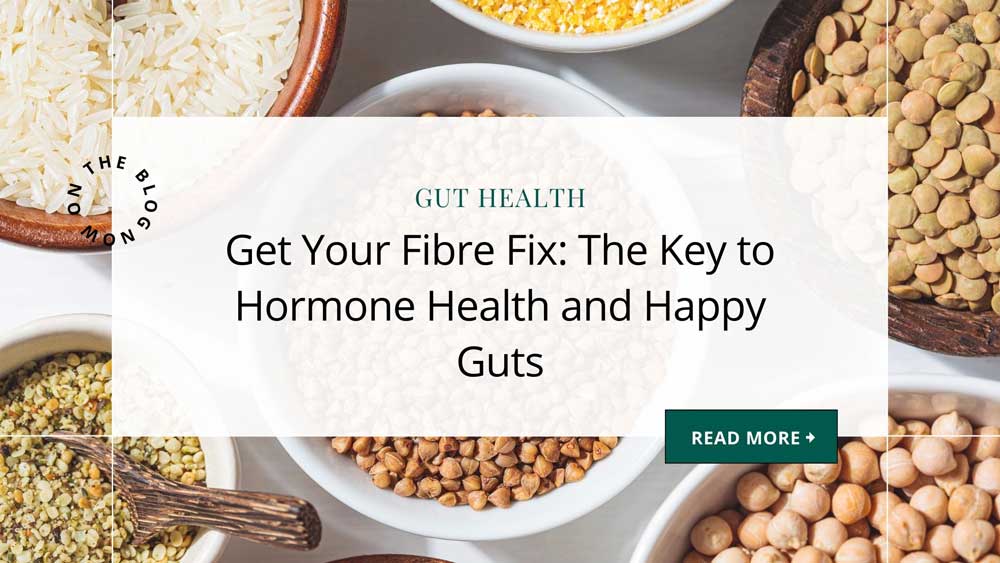Are you struggling with hormonal imbalances or digestive issues? Believe it or not, the solution could be as simple as adding more fibre to your diet.
Fibre is a type of carbohydrate found in plant foods that not only supports gut health but also plays a crucial role in hormone regulation.
In this article, we’ll explore how fibre can help balance hormones, promote a healthy gut microbiome, and share some tips on how to easily incorporate more fibre into your daily routine.
The Two Types of Fibre – Soluble and Insoluble
There are two main types of fibre: soluble and insoluble.
Soluble fibre dissolves in water and forms a gel-like substance in your digestive system. This type of fibre is known for its ability to lower cholesterol levels and regulate blood sugar levels.
Insoluble fibre, on the other hand, doesn’t dissolve in water and adds bulk to your stool. It helps keep your digestive system moving and can prevent constipation.
Foods Highest in Soluble Fibre
- Oats: Oats are a great source of soluble fibre, with about 1 gram of soluble fibre per half-cup serving.
- Beans: Beans are another good source of soluble fibre, with about 1.5 grams of soluble fibre per half-cup serving.
- Apples: Apples are a great source of both soluble and insoluble fibre, with about 1 gram of soluble fibre per medium-sized apple.
- Sweet potatoes: Sweet potatoes are a great source of soluble fibre, with about 2 grams of soluble fibre per half-cup serving.
Foods Highest Insoluble Fibre
- Whole grains: Whole grains, such as brown rice, quinoa, and whole wheat bread, are a great source of insoluble fibre.
- Nuts and seeds: Nuts and seeds, such as almonds, chia seeds, and flaxseeds, are a good source of insoluble fibre.
- Vegetables: Vegetables such as broccoli, carrots, and spinach are a great source of insoluble fibre.
Minimum Daily Fibre Requirements
To reap the benefits of fibre on your digestive health and hormone health you will want to reach the minimum requirements per day.
- Men: 38 grams of fibre
- Women: 28 grams of fibre
Fibre and Gut Health
The health benefits of fibre go beyond just regulating digestion, as it also plays a crucial role in maintaining a healthy gut microbiome.
The American Gut Project, a crowdsourced research project studying the human microbiome, found that the more diverse a person’s diet, the more diverse their gut bacteria.
Eating a diverse range of plant-based foods, including at least 30 different types per week, can help ensure that you’re getting a variety of fibre types and other nutrients that feed the different types of gut bacteria.
This can help promote a healthy gut microbiome, which has been linked to improved overall health and a reduced risk of chronic diseases.
So, not only is it important to reach your minimum fibre requirement, but it’s important to incorporate a wide variety of plant-based foods into your diet to support optimal digestive health.
If you’re wondering how on earth you can eat 30 different types of plant foods into your diet per week for optimal gut health then I can help you.
I’ve put together a 30+ plant based food challenge that can help you not only track the plant foods you are eating but also provide you with tips on how to do this easily.
You can join my free 30+ plant food challenge here.
Fibre and Hormone Health
Did you know that the food you eat can influence your hormone levels? One way this happens is through the action of fibre in reducing the activity of an enzyme called beta-glucuronidase.
If too high, this enzyme can promote the reabsorption of oestrogen from the gut back into circulation. It does this by breaking the bond between glucuronic acid and oestrogen, making it available for absorption once more. This can contribute to hormone-related health issues such as fibroids, endometriosis and heavy painful periods.
For this reason, stool testing can be really helpful in determining if your gut health is having an impact on your hormonal health. An example of this is in the image below where we can see the faecal beta-glucuronidase enzyme is exceeding the reference range.

By reducing beta-glucuronidase activity, fibre can support hormone detoxification and promote overall gut health.
How Fibre Reduces Excess Oestrogen Levels
Fibre helps to reduce excess oestrogen levels by reducing beta-glucuronidase activity. It does this by promoting the growth of beneficial gut bacteria, which produce short-chain fatty acids (SCFAs) such as butyrate.
These SCFAs can inhibit beta-glucuronidase activity and promote the excretion of conjugated hormones in the stool. When hormones such as oestrogen are metabolised in the liver, they are conjugated with glucuronic acid to make them more water-soluble and easier to excrete in the urine or bowel movements.
Reaching your minimum fibre requirement is essential for supporting healthy hormone balance and reducing oestrogen excess symptoms.
Conclusion
In conclusion, fibre is an essential component of a healthy diet and plays a crucial role in supporting overall wellbeing, digestive health, and hormone balance.
- There are two main types of fibre – soluble and insoluble, and various foods rich in each type.
- Meeting the minimum daily fibre requirements is important for optimal digestive health, as well as incorporating a diverse range of plant-based foods to promote a healthy gut microbiome.
- Furthermore, fibre plays a crucial role in hormone health by reducing the activity of beta-glucuronidase, an enzyme that can contribute to hormone-related health issues.
Blog Posts You May Like

The Gut-Immune Connection: How Secretory IgA Plays a Vital Role
As a practitioner who has been using stool testing for the last five years. I have developed a keen interest in Faecal Secretory IgA (SIgA) and its significance in understanding the gut terrain. Particularly it's relationship to food allergies, sensitivities and...

A Clients Story – Finding the Root Cause to Chronic Nausea & It’s Connection To Hormonal Health
"My health journey began in 2002 after contracting gastro from my partner at the time. After being violently ill for about 10 hours it took about 5 days before I could eat again and before I felt "ok" again. I never truly felt like myself or "normal" after that. The...

How to Avoid a Bloated Stomach After Eating
An occasional bloated stomach after eating is normal in a high percentage of the population. Knowing it's common does not make bloating after eating any more comfortable. Bloating can be especially frustrating if you're eating out socially, or finding that your bloat...


